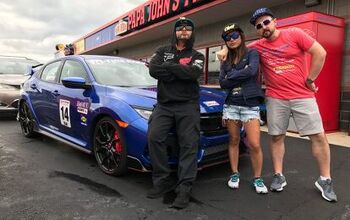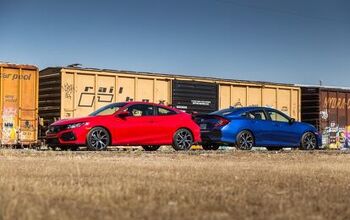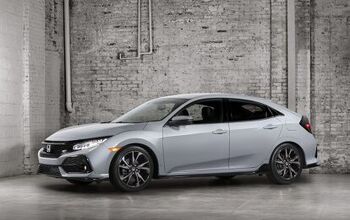2017 Honda Civic Type R First Drive - Yeah, It's All That

Let me start this review off with a promise: I will try to avoid any “VTEC kicked in, yo” jokes.
That’s in part because the 2017 Honda Civic Type R doesn’t exhibit the behavior of past VTEC engines that inspired the jokes, but mainly because the meme is played out.
Full disclosure: Honda provided us with travel to the Seattle area, and provided us with airfare, food, and lodging. They even used a seaplane to get us from Seattle to the hotel and fed us dinner on a small cruise ship. We got some track time in the Type R in addition to on-road drives. Also, they gave us seat time in go-karts, in which I spun out a lot. They left us with a scale-model Type R which will likely never leave its box. If it does, I will use it for living-room races against a scale-model Ford Focus ST I have from a previous gig, if I ever take that one out of its box.
What isn’t played out is the sport-compact (I’m avoiding the phrase “hot hatch” here to include the sedans) segment, but you knew that already. Most major players are now available in three flavors: plain (Volkswagen Golf, Ford Focus), spicy (Volkswagen Golf GTI, Ford Focus ST, Subaru WRX), and premium zest (Golf R, Focus RS, WRX STI). Honda offers the plain Civic in hatchback, coupe, or sedan form, while the spicy Si can be had as a coupe or sedan. The Type-R is available just one way – as a four-door hatchback.
The Type R is new to the U.S. but not to the rest of the world, so Honda has experience hopping up its compact. Experience that pays off.
The 2.0-liter turbocharged four-cylinder does have VTEC, but as noted earlier, this engine is different from what Honda has offered in the past. It generates 306 horsepower and 295 lb-ft of torque, and much of that torque is available at low RPMs – but I’ll get to that. For those that don’t know or don’t recall, VTEC stands for “variable valve timing and lift electronic control.” For the curious: The Type R tips the scales at 3,117 pounds. And for those who care about such things, the fuel economy is EPA-rated at 22 mpg city/28 mpg highway. It runs on regular fuel, with premium recommended.
Matched to this engine is a six-speed manual transmission with a limited-slip differential — the only gearbox available with the Type R. That’s right, if you want this car you’d better know how to shift for yourself. If you can drive a stick but can’t heel and toe very well (like me – I’m clumsy when it comes to the fancy footwork), the car comes with a rev-matching system that can be turned off if you prefer to do it yourself.
Engine exhaust flows out through a three-pipe system (complete with resonator) that Honda says avoids “booming” noises at higher RPMs.
Visually, the car is basically a Civic hatch on steroids. Key additions include a hood scoop (functional, according to Honda), air inlets, a front splitter, LED fog lamps, rear diffuser, vortex generators on the roof and out back, underbody panels to enhance aerodynamics, and a big ol’ wing on the rear decklid. The Type R is a tad wider and longer than the standard hatch, and it rides on 20-inch wheels, with wider fenders to accommodate them.
Honda press materials say that most of the aero add-ons are for more than just looks – they actually improve performance in one way or another.
The hood is aluminum, and the headlights, turn-signal lamps, brake lights, and rear taillights are all LEDs.
Styling is subjective, of course, but I’m lukewarm on the look. I don’t hate it (though it does seem a bit “boy racer” from some angles), and I know many of the components are necessary to help the car perform better on the road, but I could live without the wing. Yes, the wing helps with downforce, especially for on-track driving, and I realize it’s just personal preference, but a wing-delete option would be nice. Subaru now lets you delete the wing from the WRX STI. Buyers who never track their car might be interested in such an option.
Polarizing styling is one thing, driving dynamics are another. There’s no doubt the car shines here. Turbo lag is non-existent, and the car just pulls, no matter what gear it’s in. I forgot to downshift a couple times when speeding up on our road drive, and it didn’t really matter – the Type R just goes.
The clutch and shifter are damn near perfect, and the rev-matching system is generally smooth and not noticeable – I was aware of it only a handful of times. It’s actually a bit ironic that the clutch and shifter are so great, as the abundant torque means you won’t need to shift all that much.
That torque came in handy on the track – Honda turned us loose (semi-loose, it was a lead/follow format with a hired gun at the head of the pack) on a private track a couple of hours from Seattle – Ridge Motorsports Park. The track is 2.47 miles around, fairly technical in nature, and boasts some elevation changes.
I’m an average-at-best track driver on a good day, so Bark’s experience might be more instructive to those who plan on tracking their cars. Still, I learned a fair bit about the Type R from my two sessions.
The steering stands out – it’s precise and well-weighted, and I didn’t know it was an electric power-steering unit until the press briefing. It’s the kind of steering that gives you confidence – you point and the car goes there. Corrections and adjustments are no sweat. The Type R is also stable and surefooted – there’s just no drama.
All that torque made itself known on the straight sections of the track. I’d been content in my first session to remain mostly in third gear, but a colleague suggested I use second gear to launch out of the final section – a slow, curvy stretch meant to mimic Laguna Seca’s famous “Corkscrew” – and I picked up a lot more speed on the front straight after doing so. That’s the Type R – it has enough torque that I was fairly quick in third, but a downshift at the right time gave me a boost.
The brakes held up well, but I suspect we weren’t challenging the cars enough for brake fade to even be an issue.
Torque steer is a constant fear with high-powered front-drivers (all-wheel drive is not available with this car), but Honda uses clever engineering to mitigate it. The front suspension is a dual-axis strut system (the rear is multi-link like other Civics, but more rigid) with an adaptive damping. It all but banishes torque steer – I think I only felt it once.
Because my track skills aren’t yet fully sharpened, I appreciate a car that makes me feel like a better driver than I am, and the Type R does that. Electronics help – a +R driving mode increases the directness of the steering and the responsiveness of the rev-match system while also firming up the dampers. It also weakens the traction control system, which I left turned on per the advice of our track instructor.
Most people who buy a Type R probably won’t track it, however, so on-road dynamics and behavior will matter most. One might expect a track-focused car such as the Type R to struggle with aspects of civilized driving, but that’s not the case.
With spring rates 200-percent stiffer up front and 160 percent in the rear compared to a base Civic, one would expect a harsh ride, but no — the car is quite compliant on public roads; civilized enough for easy daily driving. The exhaust note is mostly pleasant, with little drone (on track, it was a bit unremarkable). Wind noise is properly restrained.
Tire noise, however, will be an issue, especially on long drives. It may be the car’s biggest flaw, although to be fair to Honda, the roads we were driving may have been paved with materials that increase road noise – I couldn’t confirm that. Whether that’s true or not, the tire noise is noticeable in most cases, though probably no worse, subjectively speaking, than what I heard last time I was in a WRX.
One cool thing to note: the car has three driving modes (Comfort, Sport, and +R) and unlike most cars, it defaults to Sport each time you turn it on. That seems fitting for a car of this type, but it also proved beneficial – the ride in Sport mode is balanced, while in Comfort I noticed some float. It sounds weird to say/type, but the car is actually more comfortable – or at least rides better – in Sport mode. As for handling, well, it’s just as good on public roads as it is on track.
Inside, the cabin has little touches of red trim to make sure you know it’s a Type R, and it has red sports seats that were made in house and bolstered for track driving. Unlike the Focus RS, they aren’t over bolstered, making them comfortable for daily driving, though I struggled to get the manual driver’s seat into the best position for me. As well, the manual tilt/telescope for the steering column is quite the reach. Rear seat leg- and headroom is acceptable for adults, but tall folks will want to make sure front-side riders don’t go all the way back with the seats and/or recline. The wing doesn’t really impact rear visibility in a negative way.
The center console has a slick sliding cupholder setup with a couple of layers to it. Materials are mostly on par with the competition. Unfortunately, Honda has taken another cue from the competition and uses an electronic parking brake, which is a bummer – no J-turns via handbrake for you. One cool touch is a plate with the car’s production number on it mounted aft of the shifter.
The gauge cluster changes configurations depending on the drive mode, and the steering wheel is D-cut, because of course it is. Unfortunately, since this car is based on the Civic, there’s no knobs on the radio – you’re stuck with the abominable touch slider for volume controls. I asked several Honda folks whether the knob will return, as it has in the upcoming Accord, and I was met with boilerplate responses about being unable to comment on future product, along with wrinkled faces and body language that suggest they’re tired of the question.
Knobs (or lack thereof) aside, the Type R is equipped at roughly the same level as the Touring trim of the base Civic. That means it comes with features such as Apple CarPlay, Android Auto, keyless entry and starting, 12-speaker stereo, nav, dual-zone climate control, USB, Bluetooth, and Pandora. However, for whatever reason (likely weight savings), much of the electronic driving aids and safety-assist systems usually available at this level of trim aren’t present. All you get is a rearview camera and brake assist, in addition to the (by now) ever-present stability control, traction control, and ABS. You do, of course, also get the usual compliment of airbags.
I did notice a buzzing noise from a right rear door-mounted stereo speaker at certain RPMs while on our road drive – Honda PR told me some cars at the launch, but not all, were pre-production. If ours was, that could account for the issue.
You have five exterior color choices – blue, white, red, dark gray, and black (see your Honda store for official names). There’s no choice on the inside – you’re getting red seats up front and you will like it.
What you can’t get is all-wheel drive; it’s front-drive or bust. Still, the car is priced at $33,900 ($34,775 after destination fees) and offers features that aren’t standard on the STI, Golf R, or RS. Features like navigation (not standard on the Subie), CarPlay/Android Auto (not standard on the Focus RS), and 20-inch wheels (not standard on the Golf R).
Those who like to waste time at work pricing cars online will also notice the Type R is priced just below the base versions of the RS and WRX STI (about $2K below) and about $5,500 less than the Golf R. It’s also priced around or just above loaded versions of the WRX and GTI, although about $3,000 more than a Focus ST. Indeed, the GTI Autobahn starts at just a few hundred less – a difference that’s wiped out by D and D. Add the only option package and you’re over $36K – opt for an automatic transmission and now you’re three grand up on the stick-shift-only Type R.
A top-trim WRX with the main options package (nav, blind-spot monitoring and rear-cross traffic alert, premium audio, multimedia suite) checks in just a couple hundred bucks lower, and it does offer safety goodies the Type R doesn’t.
This is all a perhaps overly detailed way of saying that Honda has positioned the Type R in a sort of sweet spot – it’s a value compared to its three key competitors (Focus RS, Golf R, WRX STI) and isn’t much of a stretch above the standard WRX, Golf GTI, and Focus ST. Those latter three are all cars it should outperform.
Yes, the Type R doesn’t offer an automatic transmission option the way the Golf R does, or all-wheel drive the way the Golf R, STI, and RS all do, but again, it’s offering similar performance for less money. Snow Belt residents, take note: Some of the bucks you save will go towards snow tires. You ain’t driving in snow on the factory rubber.
Overall, the Type R is hard to argue against. Its biggest flaws are road/tire noise, an unremarkable if not unpleasant exhaust note, and polarizing styling. Some folks will be put off by the lack of extra safety goodies (others will appreciate the weight savings) or the lack of all-wheel drive or a gearbox that doesn’t require one to use their left foot. Me, I just want a damn volume (and tuning!) knob.
Stacked against the competition, it’s a better daily driver than the high-strung RS (and probably the similarly tightly wound STI; it’s been a while since I’ve driven an STI outside of track events) but not as refined as the Golf R. The Golf R also blends into traffic better. Then again, the Type R is cheaper.
Cheaper, that is, if dealers aren’t overdoing it with markups. Since Honda is building only about 2,500 2017s and just 5,000 units per year, this car will be a little on the rare side. I put Tim to work on the markup case (privileges of rank, ya know) and he tells me that while markups were high initially, most dealers are now selling at or even below MSRP.
Yeah, the Type R is all that. And I made it nearly 2,500 words without a VTEC joke. Let’s just hope no one creates a new meme to spoil.
[Images: © Tim Healey/The Truth About Cars]

Tim Healey grew up around the auto-parts business and has always had a love for cars — his parents joke his first word was “‘Vette”. Despite this, he wanted to pursue a career in sports writing but he ended up falling semi-accidentally into the automotive-journalism industry, first at Consumer Guide Automotive and later at Web2Carz.com. He also worked as an industry analyst at Mintel Group and freelanced for About.com, CarFax, Vehix.com, High Gear Media, Torque News, FutureCar.com, Cars.com, among others, and of course Vertical Scope sites such as AutoGuide.com, Off-Road.com, and HybridCars.com. He’s an urbanite and as such, doesn’t need a daily driver, but if he had one, it would be compact, sporty, and have a manual transmission.
More by Tim Healey
Latest Car Reviews
Read moreLatest Product Reviews
Read moreRecent Comments
- V8fairy Headlights that switch on/off with the ignition - similar to the requirement that Sweden has- lights must run any time the car is on.Definitely knobs and buttons, touchscreens should only be for navigation and phone mirroring and configuration of non essential items like stereo balance/ fade etc>Bagpipes for following too close.A following distance warning system - I'd be happy to see made mandatory. And bagpipes would be a good choice for this, so hard to put up with!ABS probably should be a mandatory requirementI personally would like to have blind spot monitoring, although should absolutely NOT be mandatory. Is there a blind spot monitoring kit that could be rerofitted to a 1980 Cadillac?
- IBx1 A manual transmission
- Bd2 All these inane posts (often referencing Hyundai, Kia) the past week are by "Anal" who has been using my handle, so just ignore them...
- 3-On-The-Tree I was disappointed that when I bought my 2002 Suzuki GSX1300R that the Europeans put a mandatory speed limiter on it from 197mph down to 186mph for the 2002 year U.S models.
- ToolGuy Did anyone catch that Boeing Starliner launch earlier tonight?














































Comments
Join the conversation
"The front suspension is a dual-axis strut system (the rear is multi-link like other Civics, but more rigid) with an adaptive damping. It all but banishes torque steer – I think I only felt it once." Isn't this "clever" dual-axis strut system similar (identical) to the GM HiPer strut and Ford RevoKnuckle strut that's been in use since 2010? Why is it so clever now, but wasn't 7 years ago? It's a great idea and it undoubtedly made a HUGE difference in handling/torque steer, but to praise Honda for it? Where was the praise back then?
Yeah, well, I'm 72, a retired psychologist and engineer; the only reason I don't have an R is that my semi-disabled wife can no longer depress a clutch pedal (she drove manual trans until her back went south). Instead, we have a 2017 hatchback Sport Touring and yes, I really like the looks. So there!